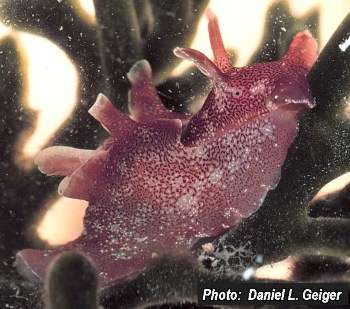
Aplysia punctata
Cuvier, 1803
Order: ANASPIDEA
Superfamily: APLYSIOIDEA
Family: Aplysiidae
DISTRIBUTION
Northeast Atlantic from Greenland to Mediterranean.
PHOTO
UPPER: Banyuls sur Mer, Mediterrean coast of France, February 1991, on Codium tomentosum.
Grows up to 20cm. Body colour variable, ranging from olive-green, brown, red, purplish-black, with blotches of grey, white, often with black or dark-brown spots and veining. The body is long and narrow and the parapodia join rather high posteriorly. produce both purple and white secretions when disturbed.
See Erwin Koehler's photos of this species mating.
Reference:
• Thompson, T.E. (1976) Biology of Opisthobranch Molluscs, Vol 1. Ray Society: London.
Rudman, W.B., 1999 (September 29) Aplysia punctata Cuvier, 1803. [In] Sea Slug Forum. Australian Museum, Sydney. Available from http://www.seaslugforum.net/find/aplypunc
Related messages
Re: Aplysia punctata mating, spawning and variations
October 3, 2007
From: Joao Pedro Tojal Loia Soares Silva

Concerning message #20473:
Dear Bill,
I'm pretty sure the animal with the pink border wasn't Aplysia fasciata. First of all, the parapodia of Aplysia fasciata do not join as "high" as these specimen. Second, they were a lot smaller (A. fasciata specimen observed only two weeks before were +20 cm, compared to less than 10 cm of these) and showing a lot more variation than Aplysia fasciata as I've ever seen.
The animal with the darker spots could be a single small Aplysia depilans but I doubt the others could be A. fasciata (which is a species I'm quite used to watch).
I'm sending a photo taken just a few days before not far away showing a similar congregation of Aplysia fasciata and you'll find they're quite different, even when they have the parapodia "closed" over the mantle one can see they stay separated quite far back. By the way, the A. fasciata were taken with 18 mm focal distance while the A. punctata were photographed with a 50 mm macro.
Locality: Berlengas island, 11 m, Portugal, North Atlantic, 29 July 2007, Rock. Length: Between 20 and 30 cm. Photographer: Joao Pedro Tojal Loia Soares Silva.
Cheers,
Joao Pedro
jpsilva@uwphotographer.net
Silva, J. P., 2007 (Oct 3) Re: Aplysia punctata mating, spawning and variations. [Message in] Sea Slug Forum. Australian Museum, Sydney. Available from http://www.seaslugforum.net/find/20526
Dear Joao Pedro,
Even thought these are photos of A. fasciata I am putting your message with A. punctata. I am sure you are correct with your identifications. The best way to identify species of Aplysia is to compare them with other species in their natural surroundings. The differences in shape are usually fairly obvious - its just difficult to put the differences into words. And when I have only photos I am usuallu quite hesitant in makling positives identifications - as I was in your earlier message.
Best wishes,
Bill Rudman
Aplysia punctata from the Western Isles, Scotland
October 3, 2007
From: Lindsay Bradley

Apologies if this is not an appropriate site to request an ID of a sea slug my family found - we are in the UK - but this looked the best sea slug site I could find on the internet.
We found this sea slug washed up by the Atlantic Ocean on Reef Beach, near Kneep, Uig, Isle of Lewis, Western Isles, Scotland. It was looking very collapsed but when we put it in a plastic drinking cup in some sea water it unfurled beautifully and seemed quite happy.
Locality: Reef Beach, near Kneep, Uig, Isle of Lewis, Western Isles, Scotland, UK, Found on the beach, Isle of Lewis, Western Isles, Scotland, UK, Atlantic Ocean, 30 September 2007, Intertidal, clean golden sands.. Length: 40 mm approximately. Photographer: Lindsay Bradley.
We have only ever seen sea slugs on TV or in books but couldn't identify what kind this is (if indeed it is a sea slug). The beach on which it was found is beautifully clean and sandy and unspoiled. We returned the sea slug carefully to the ocean, near the rocky coastline for shelter.
If anyone has any idea what kind of sea slug it is we would be really interested to know and would be very grateful.
Many thanks for your time.
Lindsay
L.R.Bradley@hotmail.co.uk
Bradley, L.R., 2007 (Oct 3) Aplysia punctata from the Western Isles, Scotland. [Message in] Sea Slug Forum. Australian Museum, Sydney. Available from http://www.seaslugforum.net/find/20877Dear Lindsay,
This is Aplysia punctata which is one of the three species of Sea Hares which can be found commonly around the UK coast at some times of the year. If you look at the relevant Fact Sheets, and the messages attached to them, you will find a lot of background information. Also if you look at the General Topics list [in Index at the top left of each page] you will find a whole section on sea hares.
Best wishes,
Bill Rudman
Aplysia punctata mating, spawning and variations
August 20, 2007
From: Joao Pedro Silva

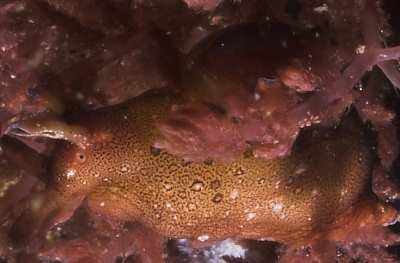
Dear Bill,
Yesterday I found lots of activity with Aplysia punctata. Many grazing, many spawning, many mating and I bet some doing all the above mentioned activities.
But I also noticed that there were more variations than I'm used to observe. In this area A. punctata are usually dark to pale brown with distinct white markings and now I've seen more or less uniform individuals, some with a light pink border on the parapodia and rhinophores and others with dark markings (instead of the white ones).
Locality: Peniche, 9 metres, Portugal, North Atlantic, 12 August 2007, Rocky bottom. Length: 3 to 7 cm. Photographer: Joao Pedro Silva.
Cheers,
Joao Pedro
jpsilva@uwphotographer.net
Silva, J. P., 2007 (Aug 20) Aplysia punctata mating, spawning and variations. [Message in] Sea Slug Forum. Australian Museum, Sydney. Available from http://www.seaslugforum.net/find/20473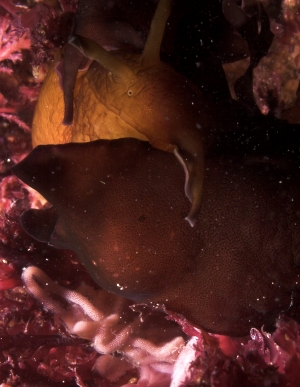
Dear Joao Pedro,
I guess its possible you have more than one species present. At this time of year it would not be surprising to have at least two species aggregating and breeding. It's hard to identify species of Aplysia from photographs, especially when you can't see the general shape of the body and structure of the parapodia. The animal with a pink border to the parapodia could be A. fasciata.
Best wishes,
Bill Rudman
Aplysia punctata mating
August 20, 2007
From: Jim Anderson

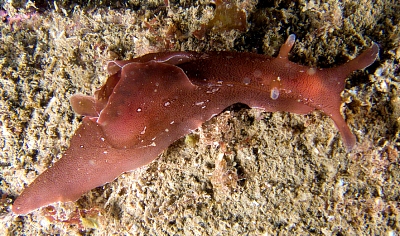
Dear Bill,
The pair were found along with several others at or around 16 metres on the reef. No sign of any spawn yet. Water temp 13 degC
Locality: Fith of Lorne, 16 m , Scotland, NE Atlantic, 12 August 2007, rocky reef. Length: 100 mm - larger. Photographer: Jim Anderson.
Kindest regards,
Jim A
jander4454@gmail.com
Anderson, J., 2007 (Aug 20) Aplysia punctata mating. [Message in] Sea Slug Forum. Australian Museum, Sydney. Available from http://www.seaslugforum.net/find/20472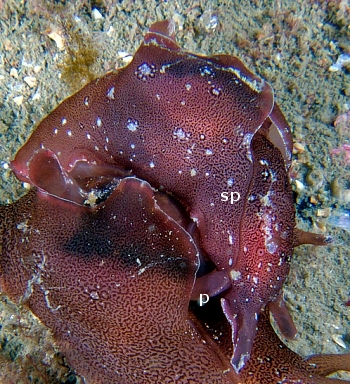
Dear Jim,
Thanks for these nice photos. For those interested in anatomical bits and pieces - in the close-up alongside we can see in the top animal (which is acting as the male), a groove running from inside the right flap [parapodia] down along the side of the head, below the eye. This is the sperm groove [sp] which carries sperm from the genital opening, which is hidden behind the right parapodia, down to the penis [p]. In this photo the penis is extended out into the genital opening of the lower animal (which is acting as the female).
Another interesting feature is the colour pattern. Some of the large white patches on the parapodia are surrounded by small white spots, each ringed in dark brown. These are remarkably similar to markings on some animals from Senegal in Marina Poddubetskaia's photos [#9803; 10382] which I tentatively identified as A. parvula. It looks like these Senegalese animals are really Aplysia punctata, and would mean that Aplysia vistosa Pruvot-Fol, 1953 - also from from Senegal, which Eales (1960) dismissed as an 'unidentifiable juvenile', is this species as well.
Best wishes,
Bill Rudman
Re: Appetitive behaviour in Aplysia
August 22, 2006
From: Mark Henry
Concerning message #17503:
Thanks for that Bill! the subject grows more fascinating the more I study it. The epiphyte idea converges much with my thoughts. Anyway Bill thanks for a fascinating discussion.
Best wishes
Mark Henry
Mark06h@aol.com
Henry, M.S., 2006 (Aug 22) Re: Appetitive behaviour in Aplysia. [Message in] Sea Slug Forum. Australian Museum, Sydney. Available from http://www.seaslugforum.net/find/17547Appetitive behaviour in Aplysia
August 21, 2006
From: Mark Henry
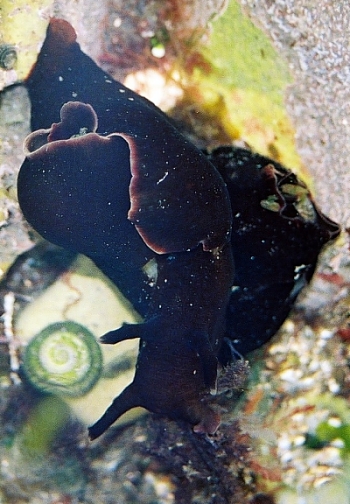
Dear Bill
Here's a picture of our old friend Aplysia. Whilst the animal demonstrates appetitive behaviour around this algae, it is not proof of a consummatory act. It is also possible that some surface, chemical aspect of this algae is palatable and the animal is checking it out. The algae looks like Corallina. Over to to you Bill what do you think?
Locality: Bridlington, 2 inches , Flamborough, England, North sea, 17 August 2006, rocky intertidal. Length: 50 mm. Photographer: Mark Henry.
Mark Henry
Mark06h@aol.com
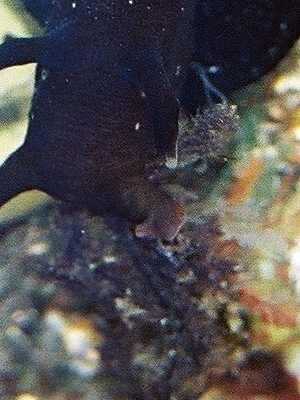
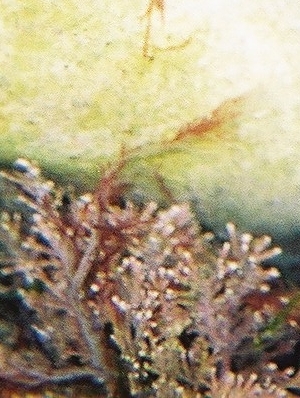

Dear Mark,
Obviously from the other side of the world I can't say I can see what's going on in your rock pools more clearly than you. What I can say is that at times it is easy to be misled when observing feeding. I have included alongside part of one of your earlier photos because it shows the pale pink jointed calcareous coralline algae very well. It also shows the Aplysia waving around another red algae - which is certainly not a coralline.
I am afraid I can't see the dark reddish-brown algae your upper animal is interested in clearly enough to identify, but both it and the whitish clump in the middle right photo, have epiphytic soft algae growing on them which is what I suspect your Aplysia are eating. The only way to be sure is to watch them - perhaps in an aquarium for a few days. You could always kill and dissect them but that is a bit drastic, and you can still be fooled by 'bycatch' - that is bits of coralline broken off when eating epiphytic algae on the coralline. All I can say is that I have never seen Aplysia eating coralline algae and I can't recall any published reference to them eating coralline algae - but I could be wrong
Best wishes,
Bill Rudman
Markings on Aplysia punctata
August 17, 2006
From: Mark Henry

Dear Bill
Over this summer season I have observed many Aplysia punctata in my area and often the colour variations are quite puzzling.
This specimen for example has strange pale spots in discrete areas, are these symbionts? parasites? or a natural colouration. If the ocelli are natural what purpose do they serve?
Locality: Flamborough, U.K., tide pools, Yorkshire, England, North sea, August 10, Rocky upper shore. Length: 60 mm. Photographer: Mark Heny.
Mark Henry
Mark06h@aol.com
Henry, M.S., 2006 (Aug 17) Markings on Aplysia punctata. [Message in] Sea Slug Forum. Australian Museum, Sydney. Available from http://www.seaslugforum.net/find/17444
Dear Mark,
As far as I know the degree of spotting is part of the natural variation of the species. I can't say I know of any study to actually prove that, but some species, such as Aplysia parvula are even more variable. Looking at your photo alongside, I can see why Aplysia are happy in your tidepools - it looks like a veritable salad bowl of delicious red, green and brown algae.
Best wishes,
Bill Rudman
A summer spawn of Aplysia punctata
August 15, 2006
From: Mark.Henry

Ranging around the cliffs of Yorkshire as I often do, looking for specimens and observing the wildlife, I notice this year a massive breeding aggregation of Aplysia punctata. They feed mainly on red algae Corallina offinalis.It may be at this time of year carotenoids are an important part of the reproductive energy requirement.At other times of the year other algae are known to be important in the diet such as Ulva species.
Locality: Flamborough Head,Bridlington., 0.5 metres, Yorkshire,Great Britain, The North Sea, 28 july 2006, Rocky intertidal. Length: 4-6inches. Photographer: Mark Henry.
Mark Henry
Mark06h@aol.com

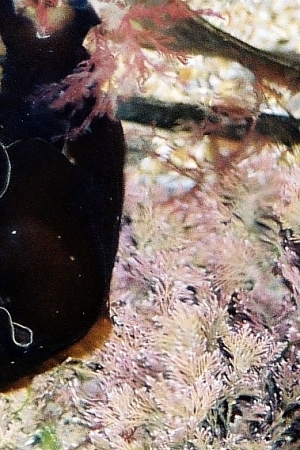
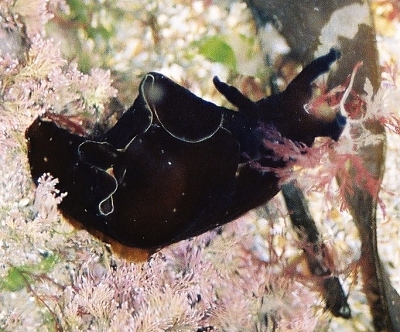
Dear Mark,
Thanks for this record of Aplysia punctata. I presume the rock with all the egg masses around the edge in your upper photo has been turned over to show the eggs?
I would be surprised if the Aplysia were eating the coralline algae. Although they do feed on red algae, in fact the red-purple ink is only produced on a diet of red algae, their radular teeth are not designed to deal with the hard calcareous walls of coralline algae. They have been reported to feed on softer reds, such as Ceramium and Polysiphonia, which are often found attached to coralline algae. In fact in your photo alongside, the red algae alongside the head of the Sea Hare is one of these softer reds. The other algae they often feed on is Ulva, the green sea lettuce, which is also present in your photos.
Best wishes,
Bill Rudman
Sea Hare from Lochiver, Northwest Scotland
March 28, 2006
From: Colin Robertson

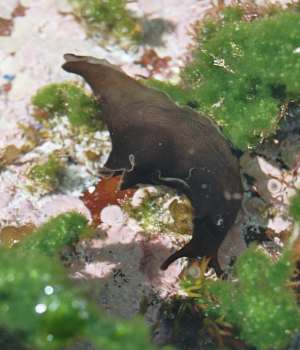
Dear Bill,
In August 2005 I found a large sea slug in a rockpool in northwest Scotland. I have not been able to identify it. I have often explored rockpools at low tide and this was a first. Photographed with standard film camera (35 to 70 mm), above water, as close as possible without falling in. I am sending separately two pictures of the lovely animal, plus a picture of the shore location. The rockpool was at top left of shore picture, in low rockpools exposed at low tide, in shallow water with plenty of sunlight and algae present. The water was under a foot deep, from memory. The slug from 3 to 4 inches long, bearing in mind image distortion air/water.
Locality: Clachtoll beach, Lochinver, north west Scotland, estimated at a foot, from memory, Scotland, UK, Atlantic ocean, 22 August 2005, shallow rock pool by edge of sandy beach, natural location. Length: estimated at 3 to 4 inches, from memory. Photographer: Colin Robertson.
Glad of any advice.
Best wishes,
Colin Robertson
crobrtsn@pt.lu
Robertson,C.D., 2006 (Mar 28) Sea Hare from Lochiver, Northwest Scotland. [Message in] Sea Slug Forum. Australian Museum, Sydney. Available from http://www.seaslugforum.net/find/16185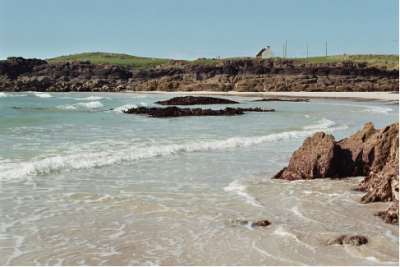
Dear Colin,
This is a species of Sea Hare. From the way its parapodia are joined quite high at the back, and its size, I guess this is Aplysia punctata. If you go to the General Topics List you will find a section with pages on many aspects of Sea Hare biology
Best wishes,
Bill Rudman
Spanish Sea Hares
February 20, 2006
From: Sascha Schulz
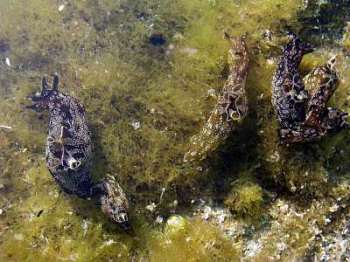
Bill,
I was given an image of Spanish Sea Hares to looks at recently. I think they are either Aplysia punctata or Aplysia depilans. Can you confirm or correct for me?
Llanca, on the Costa Brava, (north east Mediterranean coast) of Spain, real shallow. 19th March 2005,
Cheers
Sascha
ss31@dodo.com.au
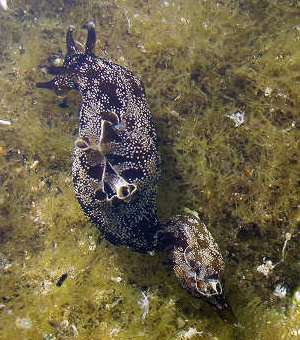
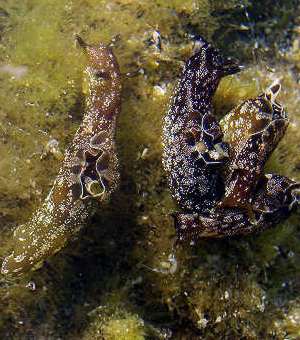
Dear Sascha,
These are Aplysia punctata. The patches of small white spots are fairly chracteristic of that species, as are the relatively small parapodial flaps which are joined posteriorly, forming a high wall at the back of the mantle cavity.
Best wishes,
Bill Rudman
Sea Hare from Spain
December 17, 2005
From: Raul Castro
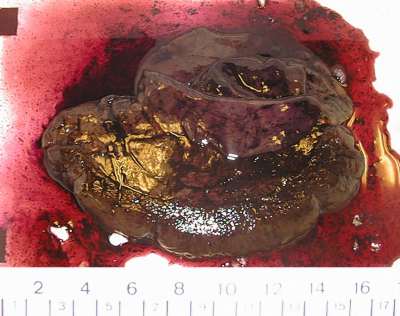
Please, help me to identify the species.
Locality: Port of Armintza, Basque Country-Spain. Bay of Biscay, Atlantic.
Depth: 2 m, Length: 220 mm. 20 November 2005. rock & sand. Photographer: Raul Castro
Raul Castro
rcastro@pas.azti.es
Castro, R., 2005 (Dec 17) Sea Hare from Spain. [Message in] Sea Slug Forum. Australian Museum, Sydney. Available from http://www.seaslugforum.net/find/15461Dear Raul,
Your photo looks like an accident in a butcher's shop. This is a Sea Hare, and the red 'blood' is the 'ink' many Sea Hares can expel from their Purple Gland. From its colour it is possibly Aplysia punctata but I can't be sure from this photo. There is a lot of information on the Forum about Sea Hares. The What is a Sea Hare Fact Sheet has links to all the relevant pages. Also look at the old messages attached to the bottom of each Fact Sheet.
Best wishes,
Bill Rudman
Aplysia punctata from Scotland
August 19, 2005
From: Cherry Welsh

I am an amateur and came across this creature in the intertidal area of Loch Indaal, a sea loch, on the Isle of Islay, west coast of Scotland.
Locality: Isle of Islay, Scotland.sea loch, opening to Atlantic. Depth: approx. 4 cm. Length: 120 mm. 23 July 2005. intertidal, sandy. Photographer: Cherry Welsh
From the comprehensive gallery of photographs on this site, it would appear that it might be Aplysia punctata.
I would be grateful for any comments.
With thanks
Cherry Welsh
cherry-welsh@glenfinlas.freeserve.co.uk
Welsh, C, 2005 (Aug 19) Aplysia punctata from Scotland. [Message in] Sea Slug Forum. Australian Museum, Sydney. Available from http://www.seaslugforum.net/find/14567
Dear Cherry,
Yes this is almost certainly the Sea Hare, Aplysia punctata. If you haven't already found it have a look at the Fact Sheet for the species for more information, and also if you go to the General Topics index at the top left of each page you will find a heading for Sea Hares which will lead you to more information than I suspect you care to find. Another source of information is Jim Anderson's Scottish Nudibranch site at http://www.scottishnudibranchs.co.uk/scotnud1.html
Best wishes,
Bill Rudman
Juvenile Aplysia from Norway
July 30, 2005
From: Kåre Telnes
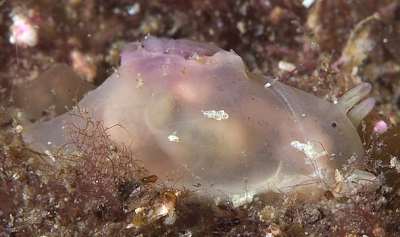
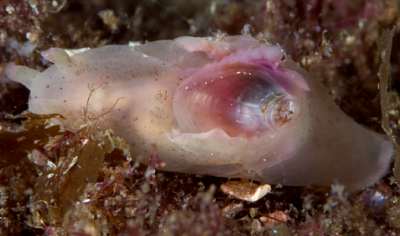
This single specimen where found on the West coast of Norway, among a huge crowd of mating sea hares. As I was too far away from home to bring Jussi Evertsen a sample. I have never seen anything like it. Do you know what it is?
Locality: Hordaland, Norway. North East Atlantic. Depth: 19 meters. Length: 15 mm. 11 July 2005. very exposed reefs, hard bottom. Photographer: Kåre Telnes
Kåre Telnes
kare@seawater.no
Telnes, K., 2005 (Jul 30) Juvenile Aplysia from Norway. [Message in] Sea Slug Forum. Australian Museum, Sydney. Available from http://www.seaslugforum.net/find/14293
Dear Kåre,
Even from so far away, I am sure your animal is a juvenile Sea Hare. From the way the parapodia are joined at the back I would guess it isAplysia punctata . In juvenile aplysiids the shell is much more exposed than in adults, but it has its characteristic flattened shape. The sperm groove running from the front of the mantle cavity/shell down the right side to the near the front of the head is a sure sign of an aplysiid, as are the four head tentacles. See the Fact Sheet on the aplysiid head for comparision.
Best wishes,
Bill Rudman
Aplysia punctata from Croatia
March 4, 2005
From: Andrej Jaklin
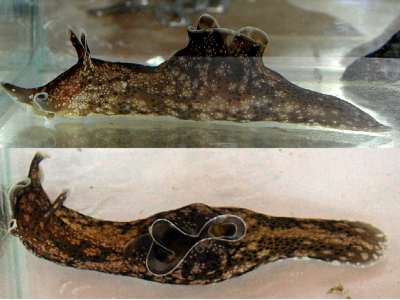
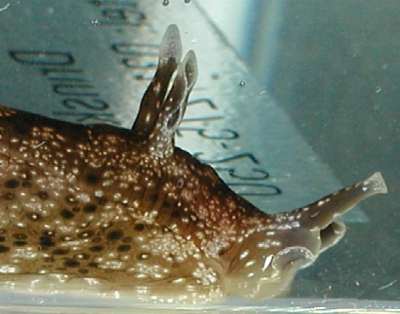
Dear Bill,
I'm sending you three pictures of presumably Aplysia punctata. All the characteristics fit to the descriptions found in literature except one tiny detail. All three specimens collected bear small dark brown spots with white centre, which make them eye like. And that should be the characteristic of another species, A. oculifera from the Red Sea.
Moreover, I found the same spots on some pictures of A. parvula from Erwin's MEDSLUG site! That raises some questions in my head and really would like to see your comment, as well as from others on the Forum.
Locality: Vrsar, Croatia, Northern Adriatic. Depth: 2 m. Length: approx 60 mm. 22 Feb 2005. Caulerpa racemosa settlement. Photographer: Dr. Bojan Hamer [in aquarium]
Best regards,
AJ
jakin@cim.irb.hr
Jaklin, A., 2005 (Mar 4) Aplysia punctata from Croatia. [Message in] Sea Slug Forum. Australian Museum, Sydney. Available from http://www.seaslugforum.net/find/13270Dear Andrej,
Sea Hares can at times be quite difficult to identify from photos. Both European species, A. depilans and A. punctata have the parapodia joined quite high at the back of the animal, as does A. parvula. In A. oculifera the parapodia are not really joined posteriorly. If your animal has a large opening or foramen in the mantle, through which the shell can be seen, then its most likely to be A. punctata or possibly A. parvula. See my earlier comments [message #1435] on the difficulty of separating those two species.
Concerning 'eye spots'. Other species do sometimes have some. For example the photos of Aplysia parvula from Senegal [message #10382] show some good eye spots. This doesn't really answer your question. I think the best way to identify species of Aplysia is to become familiar with your local populations. Once you have an idea of expected colour variablity, it is usually much simpler to identify each population to a species. I realise that it is always possible that an unusual interloper will appear, but if you know the local species reasonably well, the stray one will be fairly obvious.
Best wishes,
Bill Rudman
Aplysia from Croatia
March 4, 2005
From: Andrej Jaklin
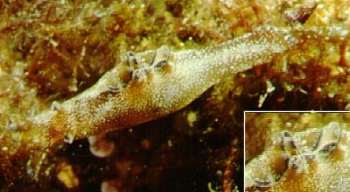

Dear Bill,
In addition to my previous message [message #13270], I'm sending two pictures on more or less the same subject. This time they were taken in situ. First one is a juvenile specimen (16 mm) which looks like A. punctata, but parapodial edges are black. Second one is of an adult(?) A. punctata, without black edges and eye-like spots.
Locality: Croatia, Northern Adriatic. Photographer: Andrej Jaklin
Any comments?
Best regards,
AJ
jaklin@cim.irb.hr
Jaklin,A., 2005 (Mar 4) Aplysia from Croatia. [Message in] Sea Slug Forum. Australian Museum, Sydney. Available from http://www.seaslugforum.net/find/13271Dear Andrej,
I guess my previous comments apply. Sometimes it is too hard from photos. Certainly the dark parapodial edge in the upper photo could suggest Aplysia parvula, but I can't see enough of the lower animal to make any comment.
Best wishes,
Bill Rudman
Age determination of Aplysia punctata
February 18, 2005
From: Marta K. Soffker
Dear Dr. Rudman,
I am with the LEMAR laboratories in Brest, France at the moment. I have found last week off the Bay of Brest several specimen of (presumably) A. punctata of about 25 cm length and about 10 cm width; just next to very small specimen who did not even reach 2 cm. I have only taken one big animal along into the aquarium; unfortunately, it died after four days.
Before I remove it, I would however like to get as much information as possible; unfortunately, I am the only one in the region to be involved in research on this species; the bibliography I have found dates back to the 70's, and I have not yet found a method to determine the age of the animal.
I would be very grateful if you could help me.
Sincerely,
Marta K. Soffker
MKSoeffker@aol.com
Soffker, M.K., 2005 (Feb 18) Age determination of Aplysia punctata . [Message in] Sea Slug Forum. Australian Museum, Sydney. Available from http://www.seaslugforum.net/find/13113Dear Marta,
Determining the age of sea slugs by size does not seem to be very simple. From the research I have read size and rate of growth often depends on external factors such water temperature on food availability. So one animal, 4 months old may bea relatively small length of x cm, because it has found little food to eat, while another animal of similar size, may be only 2 months old because it has an abundant source of food.
Most life history studies try to follow groups of animals through their life cycle, rather than measuring single individuals. The only one I know of Aplysia punctata is a study by Michael Miller in the Isle of Man. It was published in 1960 but in terms of animal evolution I don't think the species will have changed much in 40 years. You mention an animal of 25 cm. This is extremely large Aplysia punctata. If it is correctly identified, Miller's work would suggest your animal was a rare individual that has lived into a second year.
-
Miller, M.C. (1960) A note of the Life History of Aplysia punctata Cuvier in Manx waters. Proceedings of the Malacological Society of London, 34: 165-167.
Best wishes,
Bill Rudman
Aplysia punctata mating
November 27, 2003
From: Jim Anderson

Dear Dr. Rudman,
We found these Aplysia punctata today. 4 of them, approx 85mm long, in a ball all connected. In 11.5 deg C water at 12 M at Maiden Island near Oban on the west coast of Scotland. I seperated them out to see what would happen. They were placed about 250mm apart and within 5 minutes had reassembled. Initially they 'reared' up from the bottom tasting/smelling the water then headed more or less for one another. I didn't see the final agregation (shortage of air!) but they were nearly all there.
Regards,
Jim A
jander4454@blueyonder.co.uk

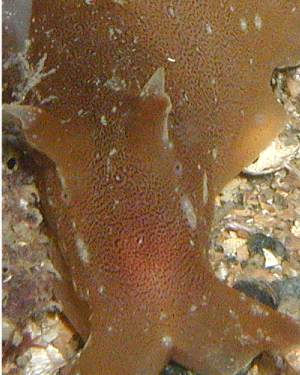
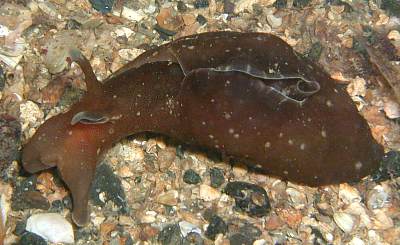
Thanks Jim,
Mating aggregations are certainly a common occurrence among Sea Hares. I included a close-up of the head of one of the animsls as it shows the typical colour pattern. I have just noticed that it seems to have had an accdent with its rhinophores and is apparently growing new tips
Best wishes
Bill Rudman
Aplysia punctata from French Mediterranean
July 19, 2003
From: Marina Poddubetskaia

Dear Bill,
Here are some large Sea Hares from Cerbere. Are they all Aplysia punctata ?
The darker animal I have sent in a separate message is confusing me a little because of its pale red border to the parapodia. Your opinion is very welcome.
Location : Cerbere, France, Mediterranean coast
Upper Right Photo:
Date: July 13, 2003
Site: Les Chambres
Depth: 7m
Size: 95-100mm
Lower Photos:
Date: July 07, 2003
Site: Cap Negre
Size: 55-60mm
Photos: Marina Poddubetskaia - Nembro website
Cordially,
Marina.
nembro@nembro.info


Dear Marina,
It's not always possible to identify Sea Hares without looking at their anatomy but I am pretty sure these are both Aplysia punctata. You will note that the parapodia are joined posteriorly very high up, which is characteristic of A. punctata and A. depilans. However in the lower left photo I can see that the mantle foramen [hole in mantle into shell cavity] is quite large which is only found in A. punctata.
Best wishes,
Bill Rudman
Aplysia punctata (adult) from French Brittany
April 29, 2003
From: Marina Poddubetskaia

Dear Bill,
I spent last week-end diving near the famous Mont Saint-Michel and I found there some nice guys. For example, this large Aplysia. It looks a little like Aplysia punctata, but it seems to me quite different from the usual colour form. What do you think about it?
I include a close-up of the foramen [lower left]. I think the yellowish thing we can see here is the internal shell of this animal, isn’t it ?
Saint-Malo, France, Atlantic coast. Site: Bizeux., Depth: 4,5m., Size: 14-15cm., Temp: 12°C. April 19, 2003. Photos: Marina Poddubetskaia - Nembro website
Best wishes,
Marina.
nembro@nembro.info



Dear Marina,
I would say this is an adult Aplysia punctata. Compare this with the animal in your other message, which is a juvenile. This is the only species from that part of the world, with this colour pattern, in which the parapodia are joined posteriorly and the mantle foramen is large. For those of you not familiar with the term foramen, it is from the Latin word for a window and refers to the hole in the mantle through which the shell can be seen. In some species such as A. punctata and A. parvula it is large and the shell is easily seen, while in many it is an almost invisible pore, often on a short papillae. In the labelled close-up alongside you can also see a flap of mantle tissue which forms a siphon or spout directing water out of the mantle cavity.
Concerning the difference in shape and colour between these animals and those in your other message, the others are juveniles which are often red or reddish in colour. However the joined parapodia and large foramen are clearly visible
Best wishes,
Bill Rudman
Aplysia punctata (juvenile) from French Brittany
April 29, 2003
From: Marina Poddubetskaia

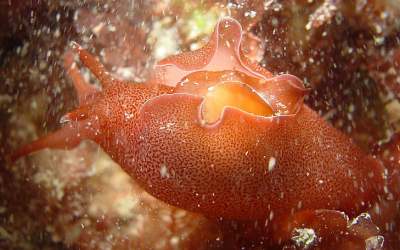
Dear Bill,
To accompany my other photos, here is another smaller Aplysia from Saint-Malo. It looks like the photos of Aplysia punctata you have on the Forum, but it seems to me quite different from the large animals I know. Is it a juvenile colouring or is it just a different colour form of this species ?
Saint-Malo, France, Atlantic coast. Site: Conchee., Depth: 9m., Size: 45-50mm., Temp : 12°C. April 20, 2003. Photos: Marina Poddubetskaia - Nembro website
Best wishes,
Marina.
nembro@nembro.info
Poddubetskaia, M., 2003 (Apr 29) Aplysia punctata (juvenile) from French Brittany. [Message in] Sea Slug Forum. Australian Museum, Sydney. Available from http://www.seaslugforum.net/find/9758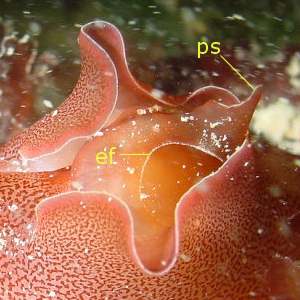
Dear Marina,
As I discuss in your other message, I am pretty sure this is a juvenile of A. punctata. The foramen is very large in this species - I have labelled the edge of the foramen ef in the close-up alongside, and the ps exhalent pallial siphon, which is fully extended in this photo.
Best wishes,
Bill Rudman
Aplysia punctata in aquarium
November 10, 2002
From: Michael
I believe I have a Aplysia punctata. It looks just like most of the pictures on the species ID page. I was wondering though, is it possible he may like to eat a few day old baby brine shrimp? He is all over the 5 gallon tank I have him in. He spends a lot of time on the glass too. But when I add the BBS for the seahorses he usually goes to the top of the tank on the glass and hangs off the glass and it almost looks like he's going after the BBS. Is is possible? Also, I've now had him for a month and he seems to be doing really good.
Thanks in advance,
Michael.
Bastianelli@chartermi.net
Michael, 2002 (Nov 10) Aplysia punctata in aquarium. [Message in] Sea Slug Forum. Australian Museum, Sydney. Available from http://www.seaslugforum.net/find/8389Dear Michael,
I guess it's possible there is some smell associated with the brine shrimp that stimulates it, but all Sea Hares are herbivores so brine shrimp is not for them. Are you feeding your Aplysia or are you hoping it will eat algae off the glass or rocks in your aquarium?
Best wishes,
Bill Rudman
Re: commensal bivalve & Aplysia
June 18, 2002
From: Dr.Stephen R Hoskins
Dear Bill,
I'm indebted to you for solving my "bivalve" sighting. Never did it occur to me that Aplysia's own shell could migrate outside of its body. Well, that's something else that I've learned about these fascinating animals. I shall continue to review the Forum's messages and hopefully contribute again in the future. Thanks for giving amateurs like myself access to such a
dynamically interactive site.
Very best wishes and thanks again.
Stephen.
SRH@4TheNet.co.uk
Hoskins, S.R., 2002 (Jun 18) Re: commensal bivalve & Aplysia. [Message in] Sea Slug Forum. Australian Museum, Sydney. Available from http://www.seaslugforum.net/find/7287Re: Commensal bivalve - Sea Hare
June 17, 2002
From: Dr. Stephen R. Hoskins

Dear Bill,
I have attached the digital photo showing the bivalve attached to the sea hare, both of which I preserved. I have tried to "clean" up the bivalve part and hopefully its colour will be more appreciable against the dark sea hare.
Thanks,
Stephen.
SRH@4TheNet.co.uk
Hoskins, S.R., 2002 (Jun 17) Re: Commensal bivalve - Sea Hare. [Message in] Sea Slug Forum. Australian Museum, Sydney. Available from http://www.seaslugforum.net/find/7271Dear Stephen,
Thanks for the photo - it certainly puts a new light on your observation. The shell is in fact the shell of the Sea Hare. Have a look at the Sea Hare Shell page and my comment on the Sea Hare siphon for an idea on Sea Hare anatomy. In most species of Sea Hare the shell is well enclosed within the mantle tissue, but in a few species like A. punctata and A. parvula there is a wide opening [mantle foramen] in the mantle tissue exposing quite a bit of the shell to the outside world. When these animals get old and worn out, this opening gets bigger and bigger as the mantle tissue loses 'muscle tone' and the shell becomes even more exposed.
It would have been nice if you had found a new association for a galeommatid bivalve, as we know very little about their natural history, but at least its nice for you to know why these apparent bivalves were hanging on so tightly!
Best wishes,
Bill Rudman
Re: galeommatoidean commensal on Aplysia?
June 13, 2002
From: Serge Gofas
Dear Bill,
The possible association between a bivalve and a Sea Hare would be totally novel. Not only on Sea Hares, but I do not remember any documented Galeommatoidean association with another mollusc (but Epilepton spp. are found on Sipuncilids: not too far!) So why not?
All the best
Serge
Serge Gofas
Profesor titular
Departamento de Biología Animal
Campus de Teatinos - E-29071 Málaga, Spain
sgofas@uma.es
Gofas, S., 2002 (Jun 13) Re: galeommatoidean commensal on Aplysia?. [Message in] Sea Slug Forum. Australian Museum, Sydney. Available from http://www.seaslugforum.net/find/7240Thanks Serge,
I couldn't recall any association, so thanks for the confirmation.
Bill Rudman
Aplysia punctata and commensal? bivalve.
June 8, 2002
From: Stephen Hoskins
Dear Bill,
A short while ago I posted an observation regarding a bivalve being firmly clamped across the opening of the mantle cavity of a living Aplysia punctata and you replied that it may be a chance encounter or a new form of association. I have now encountered the phenomenon again and my question is why would the bivalve site itself across the opening of the mantle cavity?
Stephen.
SRH@4TheNet.co.uk
Hoskins, S., 2002 (Jun 8) Aplysia punctata and commensal? bivalve.. [Message in] Sea Slug Forum. Australian Museum, Sydney. Available from http://www.seaslugforum.net/find/7174Dear Stephen,
While one sighting could easily be a coincidence, two sightings starts to sound quite interesting. Have you photographed this or kept any specimens? I would encourage both, as I am sure we could find someone who could help you identify the bivalve - which is probably only known from an empty shell. In my last comment to you I suggested that if the bivalve was a commensal then it was most probably a leptonoidean. In fact the oldest name for the superfamily is Galeommatoidea [Southern Synthesis Part A, 1998].
Why is the bivalve situated near the opening of the mantle cavity? Many commensals position themselves near water currents. This is particularly useful for filter feeding and deposit feeding commensals, such as bivalves, as it enables them to filter food particles out of the incoming water current, and to intercept, and perhaps eat, faecal and waste material from the outgoing current. The position of your bivalves then is another indication that you may have found a commensal association. If you are interested I could try and find a bivalve expert for you to collaborate with.
Best wishes,
Bill Rudman
Aplysia punctata in Germany
May 31, 2002
From: Peter Gleisenstein
A few days ago, 26Th May 2002, I observed a lot of slugs near Flensburg, Germany at a depth from 2 to 10 m in a field of Mytilus edulis in the Flensburger Förde (Baltic Sea, salinity approx. 1 to 1,5 %). The looked for me like Aplysia punctata. Colour between red and brown with a lot of whitish spots. The size was 2 to 4 cm.
Is this possible, or does a different species of the genus Aplysia fit the description?
with greetings
Peter Gleisenstein
gleisi@foni.net
Gleisenstein, P., 2002 (May 31) Aplysia punctata in Germany. [Message in] Sea Slug Forum. Australian Museum, Sydney. Available from http://www.seaslugforum.net/find/7085Dear Peter,
I can't say I am an expert on European aplysiids, but from the colour variation it sounds like A. punctata. I also think it the only species that reaches as far north as the Baltic, being reported from Greenland and Norway.
Best wishes,
Bill Rudman
Aplysia punctata & 'passengers'
May 16, 2002
From: Dr. Stephen Hoskins
Last week whilst undertaking field work on Jersey I made detailed observations of Aplysia punctata activity in situ and noticed on several occasions that a small bivalve was firmly (resisted efforts to pull it free) clamped on the parapodia close to the opening of the mantle cavity and also a small topshell attached to the animal's body just above the foot. Were these animals simply hitching a ride? Has anyone reported this before? Any suggested ideas?
Dr Stephen Hoskins
SRH@4TheNet.co.uk
Hoskins, S., 2002 (May 16) Aplysia punctata & 'passengers'. [Message in] Sea Slug Forum. Australian Museum, Sydney. Available from http://www.seaslugforum.net/find/6971Dear Stephen,
I suspect the top shell is a chance hitchhiker but it is possible the bivalves have a relationship with Sea Hares. I can't recall any published association between a bivalve and a Sea Hare but there are numerous small bivalves which show a range of commensal and semi-parasitic relationships with other molluscs, crustacea, echinoderms and worms. Most examples are found amongst the leptonoidean bivalves. We know nothing about the biology of most species of the group and new associations are regularly being reported so it would not be that surprising if you had discovered a new association - but then again it could be just be a coincidence.
Best wishes,
Bill Rudman
Aplysia punctata from Portugal
April 23, 2002
From: João Tojal Silva
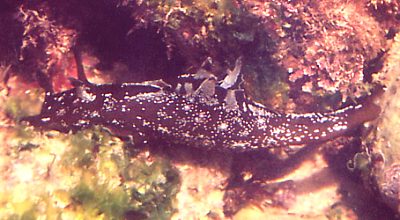

Dear Bill,
Here are the photos of Aplysia punctata to accompany those of A. depilans. They were photographed during the low tide in Baleal (Portugal) [early April 2002]. I saw dozens of Aplysia punctata, some mating, in rock pools no more than 50cm deep. The A. punctata were no bigger than 6-7cm long.
Hope you like them!
All the best,
João Pedro
joao.tojal.silva@NOVABASE.PT
Silva, J., 2002 (Apr 23) Aplysia punctata from Portugal. [Message in] Sea Slug Forum. Australian Museum, Sydney. Available from http://www.seaslugforum.net/find/6789Thanks João,
Bill Rudman
Aplysia punctata defensive mechanism
December 13, 2000
From: Marilyn Jackson
Dear Bill,
After finding several Sea Hares on the sea shore I transferred them to a rock pool and was amazed to see a cloud of purple rising from the animals.
I initially thought I had damaged the creatures but came to the conclusion that they emitted some kind of warning/defensive chemical. Could you tell me what the chemical is and, if possible, what the active ingredient is which gives it its distinctive colour.
Regards
Marilyn Jackson
St Sampsons School,
Guernsey
auntiemin@gtonline.net
Jackson, M., 2000 (Dec 13) Aplysia punctata defensive mechanism. [Message in] Sea Slug Forum. Australian Museum, Sydney. Available from http://www.seaslugforum.net/find/3302Dear Marilyn,
Most species of Sea Hares can release a cloud of red or purple ink when they are disturbed. It has been likened to the defensive cloud of ink produced by an octopus but there is no evidence to support that idea. The ink is largely composed of pigments derived from the red algae they feed on - primarily phycoerythrin or similar compounds.
Have a look at the Sea Hares - defence for some general information on the secretions and look at the other pages on Sea hares listed on the Sea Hares Page. Make sure you look at the other messages at the bottom of each page because there is always a lot of information there as well. I recently noted a new review on Sea Hare defence mechanisms which would be worth having a look at.
Best wishes,
Bill Rudman.
What does Aplysia punctata eat?
August 7, 2000
From: Trevor Shand
I know that sea hares eat algae (seaweeds) but does it have to be a particular type of seaweed for a certain Sea Hare. At the moment I have a Aplysia punctata and would like to know what seaweed is best to feed it with.
Trevor Shand
trevor.shand@lineone.net
Shand, T., 2000 (Aug 7) What does Aplysia punctata eat?. [Message in] Sea Slug Forum. Australian Museum, Sydney. Available from http://www.seaslugforum.net/find/2850Dear Trevor,
Good question! I am sure some research worker or student must have studied the diet of this common Sea Hare but from a quick look around I can't find much in the way of information except for Thompson's (1976) references to studies conducted in 1914 and 1921. Many Sea Hares are thought to settle out of the plankton on to red algae, on which they feed, and then gradually move to brown and green algae as they move upshore.
In the case of A. punctata it is reported to feed on the red algae Polysiphonia and Ceramium when young, and then move to the brown alage Fucus and the green Ulva as it moves up the shore. However the whole idea of migration up the shore is also disputed.
If you are keeping these animals in an aquarium my advice would be to try the Sea Lettuce Ulva as both red and brown algae are quite difficult to keep alive in aquaria and they also release chemicals into the water which could kill other life in your tank. Ulva on the other hand is quite tolerant of a wide range of enviromental conditions and as far as I know, doesn't release nasty substances into the water.
I would be interested in any information on research that has been conducted into the feeding biology, and other aspects of the life history of A. punctata
Reference: Thompson, T.E. (1976) Biology of Opisthobranch Molluscs, Vol 1. Ray Society: London.
Best wishes,
Bill Rudman.
Observations on Aplysia punctata
October 2, 1999
From: Andy Horton
Dear Bill,
Here are some observations from May 1999, English Channel.
Sea Hares, Aplysia punctata, have been reported in large numbers from just off the Isle of Purbeck on the Dorset coast (Jane Lilley), near Portland Harbour on the Dorset coast (Bob Alexander) and Saline Bay in Guernsey, Channel Islands (Richard Lord). All reports of this mollusc are of interest. It will not be until next month that we will know if it is a year of abundance, when Sea Hares come inshore to spawn and then die on the shore and in shallow water. In July they were also reported from the mouth of the Rive Exe, Seaton, Devon,(Peter Glanvill) and in hundreds off Lulworth Cove, Dorset (Chris Davis, Marine Conservation Society).
Andy Horton
bmlss@compuserve.com
Horton, A., 1999 (Oct 2) Observations on Aplysia punctata. [Message in] Sea Slug Forum. Australian Museum, Sydney. Available from http://www.seaslugforum.net/find/1379